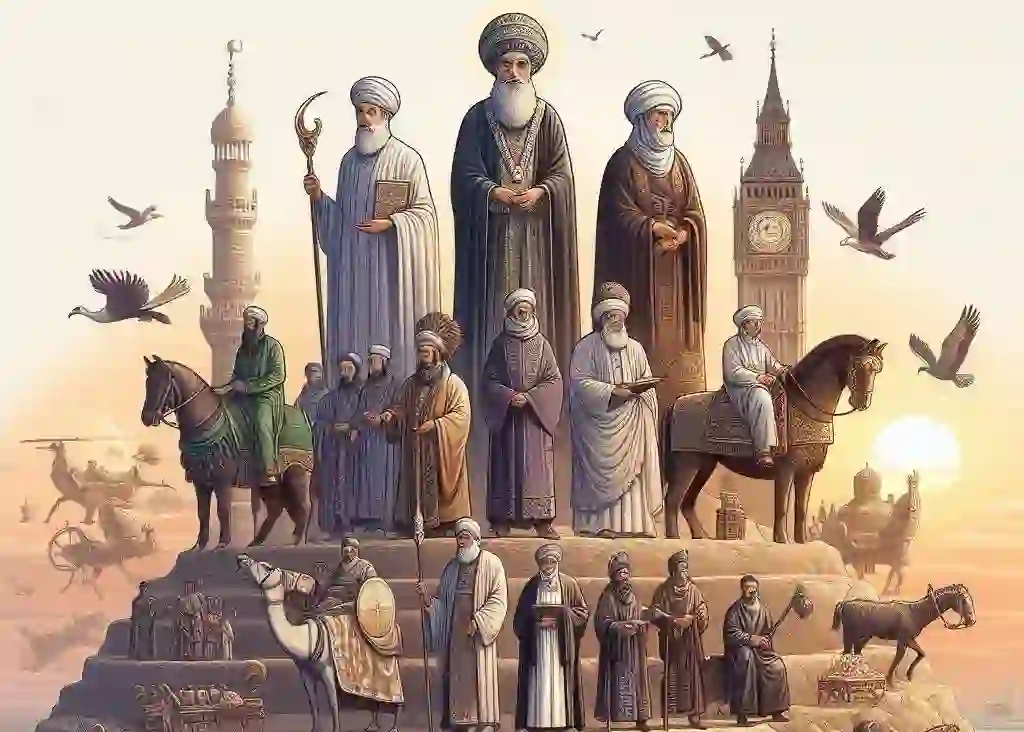Muslim Law In India - Historical Development And Sources
Islamic Law is a set of rules in Islam that tell Muslims how to live their lives. It shows them how to act towards God and other people. Prophet Muhammad said that this law is from God, and it is very important for Muslims to follow it carefully. The word Islam means peace through following God’s will.
People who follow Islam are called Muslims, meaning they have chosen to live by God's teachings. In India, when it comes to personal issues like marriage, divorce, and family matters, the laws that apply are based on the individual's religion.
For Muslims, this means their personal laws are based on Islamic teachings, along with Indian laws and court decisions that have been added over time.
So, if a person is Muslim, Indian courts will use Muslim Law to decide on their personal matters.
Muslim Identity: Who Are Muslims?
Muslim law focuses on family matters for people who follow Islam. The word "Muslim" comes from "Islam" and means someone who believes in the Islamic faith. There isn't an official definition of what it means to be a Muslim. Islam is a religion that's all about believing in and following God's will. To put it simply, Islam is a religion where people believe in giving themselves over to what God wants.
- God (Allah) is the one and only god; and,
- Prophet Muhammad is his messenger (Rasool).
Thus, anyone who believes in these principles is considered a Muslim.
Since faith in Islam is a personal matter and hard to prove in court, the Courts recognize someone as a Muslim if they:
advertisement
-
Muslim by Birth: If a person’s parents are both Muslim, they are considered Muslim by birth. If only one parent is Muslim, the child is regarded as a Muslim only if they are raised as one, as decided in the case of Bhaiya Sher Bahadur v. Bhaiya Ganga Baksh Singh (1914). A person born Muslim will remain so unless, upon reaching adulthood, they publicly renounce Islam.
-
Muslim by Conversion: A person who is mentally sound and of legal age can convert to Islam in two ways:
- To convert to Islam, a person must publicly declare that they are leaving their original religion and accepting Islam. They must also believe that Allah is the only God and that Prophet Mohammad is His messenger.
- Conversion to Islam can also happen through Islamic ceremonies. The person goes to a mosque, where the Imam (Imams are religious leaders in Islam. They lead daily prayers, teach about the Quran and the life of Prophet Mohammed, conduct weddings and funerals, and manage youth programs at their mosque) may ask them to recite the Kalema (a declaration of faith) and give them a Muslim name. This new name is then recorded in the Imam’s register.
If a person formally professes Islam, they are considered a Muslim. However, this conversion should not be done through deceit or to evade any laws. If their actions and behavior go against Islamic principles, the assumption of their conversion can be challenged.

A Historical Overview
Prophet Mohammed spread the Islamic religion and built a growing community around it. After he died in 632 AD, he didn’t choose a successor. This led to a split:
- SHIAS: Believed that only people related to Mohammed by blood, like his cousin Ali, should lead the Muslim community.
- SUNNIS: Thought that the leader should be chosen by the community’s agreement. They elected three of Mohammed’s trusted friends to lead.
This division created two main groups in Islam: SHIAS and SUNNIS.
advertisement
FIRST PERIOD:
This period starts with the Hijra (migration to Medina) and ends with the death of the Prophet. Its main contribution is the creation of laws. During this time, the Prophet worked to spread Islam's teachings. In Medina, the Prophet Muhammad established principles to guide people's behavior based on the revelations he received in Mecca.
These revelations were later recorded as the Quran. Additional laws were derived from the Prophet's actions, sayings, and silence, known as the Sunnah. This period was when the core legal principles of Islam were defined and set.
SECOND PERIOD:
This period is known as the time of the first four Caliphs, or Khulafa-i-Rashidun (the rightly guided Caliphs), who were close companions of the Prophet. The term ‘Caliph’ means successor. After the Prophet's death, there was a debate about who should lead the Muslim community.
Most people agreed on electing a leader, so Abd Allah Ibn Abi Quhafa, commonly known by the kunya Abu Bakr, the Prophet’s father-in-law, was chosen as the first Caliph. After his death, Umar ibn al-Khattab was elected as the second Caliph but was assassinated in 644 AD.
advertisement
Uthman ibn Affan became the third Caliph but was also assassinated in 656 AD. Finally, Ali ibn Abi Talib, who was married to the Prophet’s daughter Fatima, was elected as the fourth Caliph but was killed in 661 AD.
During this period, the scattered divine revelations given to the Prophet were collected and organized into the Quran. The first compilation was done by Zaid, a close companion of the Prophet, during Abu Bakr’s rule, but it was later discarded due to flaws and contradictions.
Utham, the third Caliph, asked Zaid to redo the compilation, leading to the Quran as it is known today. The Quran and the traditions of the Prophet became the main sources of Muslim law. Additionally, Umar, the second Caliph, appointed the first judge (Kazi) to handle legal disputes and established that the law is supreme and above all.
THIRD PERIOD:
Ali was the last of the ‘rightly guided Caliphs’ and had two sons, Hasan and Hussain. After Ali died, Hasan became Caliph but chose to step down in favor of Muawiya from the Umayyad family because he did not want to handle administrative duties.
advertisement
This change moved the Caliphate’s center from Medina to Damascus and made the position hereditary rather than elected. Muawiya’s son, Yezid, then became the next Caliph. At Yezid’s request, Hasan was poisoned, although Hasan wasn’t involved in administration.
Hussain tried to rebel against Yezid but was killed at Karbala. As the Caliphate turned into a hereditary monarchy, the focus shifted from legal development to expanding the empire. In 750 AD, the Abbasids, descendants of the Prophet’s uncle Abbas, overthrew the Umayyad dynasty and made Baghdad the center of power.
The development of Islamic law came from the work of scholars in Mecca, Medina, and Kufa. However, there were often differing opinions and interpretations, leading to the formation of various sub-sects, each claiming to have the correct understanding.
To address this, the traditions of the Prophet were collected, and the most authoritative ones were accepted as law. Notable collections include those by Bukhari and Malik-Ibn Malik.
When the Quran and traditions did not cover certain issues, scholars created theoretical explanations. During this period, methods like Ijma (consensus) and Qiyas (analogy) were established. This approach led to a scientific and logical way of developing laws, incorporating principles such as equity, reasoning, and public welfare.
advertisement
FOURTH PERIOD:
In 1258, the Moghuls took over from the Abbasids, who had been in charge for 500 years. In 1261, Abdul Kasim Ahmed became the new leader, but his family didn’t have much power. In the early 1500s, the leader's role moved to the Ottoman ruler Selim I, and the main center of power changed from Cairo to Constantinople (now Istanbul).
Later, in 1922, Mustafa Kamal Ataturk ended the Turkish Sultanate, and in 1924, the Caliphate was also abolished by the National Assembly in Ankara (Capital of Turkey).
During this time, four main Sunni legal schools were set up. But there wasn’t much new development in the law, as no one was allowed to make their own interpretations. Instead, people followed existing rules and wrote detailed explanations of them. These explanations were called Fatwas. Two important Fatwas from this period are the Fatawa-Alamgiri and Fatawa Qadi Khan.
FIFTH PERIOD:
After the Caliphate ended, there was no longer a religious leader to enforce Islamic law. It became necessary to separate Islamic law from religion. New laws were created and organized to fit modern society while keeping some core principles of Islamic law. Areas like criminal and civil law were specifically excluded from the traditional Islamic law.
Under the Mughals, Muslim law was used for all legal matters. The British changed this system. They applied Muslim law only to personal issues like marriage and divorce, while other laws were based on British rules. After India became independent, this mixed system continued.
For example, the Shariat Act applies Muslim personal law to issues like marriage and maintenance, but there are exceptions, such as for land. Later, new laws like the Dissolution of Marriage Act (1939) and the Muslim Women (Protection of Rights on Divorce) Act (1986) were introduced. These laws sometimes adjust or expand on traditional Muslim law.
Indian courts also interpret Muslim law to fit modern needs, so judicial decisions have become part of the legal system in India.
advertisement

SOURCES OF MUSLIM LAW.
The word ‘source’ means where something comes from. In this case, it means where Muslim Law gets its rules and ideas. The recognized sources of Muslim Law are:
Primary Sources:
- Quran;
- Sunna (Tradition);
- Ijmaz;
- Qiyas; and
- Equity and the Absolute Good.
Secondary Sources:
- Istehsan;
- Al-masalih-al-mursalah;
- Istidlal;
- Istishab;
- Ijtihad; and
- Taqlid
Other Sources:
- Legal Fiction;
- Precedent;
- Positive Legislation;
- Custom.
advertisement
Primary Sources - Quran:
It's a book that has word-by-word instructions and rules from Allah, given to Prophet Muhammad by the angel Gabriel. It's the main guide for laws.
The Quran was revealed over 22 years and a few months. For 12 years, 5 months, and 13 days, it was revealed in Mecca, and the rest was in Medina. The Quran is divided into 114 chapters, called ‘Souras’ each with a different name.
It has about 6000 verses called ‘Ayats.’ Out of these, fewer than 200 verses deal with laws and were revealed in Medina. The verses from Mecca focus on beliefs, Islam, and life philosophy.
When interpreting the Quran, one important rule is that some verses replace or cancel out others. The verses that cancel are called ‘abrogating’ (Nasik), and the verses that get replaced are called ‘abrogated’ (Munsuk).
Because the Quran comes from Allah, Muslims believe that their laws can't be changed by people. So, in India, Muslims argue that their laws can't be changed by the national or state governments. But, in many Muslim countries, this view has been ignored.
The Quran is important for many reasons: religious, spiritual, legal, political, moral, and social. Its legal importance comes from having 200 verses about law.
Out of these, 80 verses are about family matters, like marriage and divorce, while the rest deal with government and politics.
The Quran provides the rules for things like marriage, money given to a wife, divorce, guardianship, and inheritance.
Primary Sources - Sunna:
The word ‘Sunna’ originally meant a way or method. Before Islam, it referred to the old traditions of the community. In Muslim law, ‘Sunna’ now means the actions and approvals of the Prophet Muhammad, including what he said and did.
The word ‘Sunna’ is sometimes mixed up with ‘Hadith;’ ‘Hadith’ is a story about a specific event or situation, while ‘Sunna’ is the general rule or lesson learned from those stories.
Sunna is categorized based on when it was collected, how it was shared, and how true it is. Like the Quran, Sunna is not just about laws; it also covers beliefs, business, ethics, and government.
The Sunna is very important for Muslim law. The Quran mentions its importance, the Prophet Muhammad stressed it, his early followers supported it, and all major Muslim scholars accept it.
advertisement
A verse in the Quran runs as, whatever the Prophet gives, accept it and whatever he forbids you, abstain from it (49.7). It also says “he does not speak out of his desire. It is ought, but the revelation revealed (to him).”
The Prophet once told his followers: “As long as you stick to two things I’ve left with you—God’s Book (the Quran) and my Sunna (my actions and teachings)—you won’t go wrong.”
The Prophet’s successors followed his example. If they did not know his decision on a topic, they asked his companions. If a companion provided a Hadith about it, they used that Hadith to make their decision.
They always checked the trustworthiness of the traditions before using them. All major traditional Muslim scholars agree that Hadith is a valid source of Islamic law.
The purpose of Sunna is to explain and expand on the Quran. It helps people understand the Quran’s teachings and shows how to apply its principles and laws. For example, laws about gifts, trusts, and property rights were introduced through Sunna, while rules about marriage, dowries, divorce, and wills, which are in the Quran, were further developed through the Prophet’s traditions.
Primary Sources -:Ijma:
‘Ijma’ means that the followers of Muhammad PBUH(Abbreviation for “peace be upon him” which Muslims say after the Prophet Muhammad's name out of respect) agree on a legal question.
According to Fayzee, a modern expert on Muslim Law, 'Ijma' is when the knowledgeable people in the community all agree on something. Most legal experts see it as the third source of Islamic law. However, some modern experts think it’s the most important part of Islamic law. The authority of Ijma comes from the Quran, the Sunna, and reasoning.
“O ye who believe; obey God and obey the Prophet, and those of you who are in authority, and if ye have a dispute concerning any matter, refer it to God and the prophet” (Quran 4:5a)
“There can be no consensus on error, or misguided behavior amongst my people”.(Hadith). Ijma can be based on what people say or how they act, and both ways are equally important.
To make Ijma valid, these rules must be followed:
- Once a question is decided, individual jurists cannot change it.
- A new Ijma can change a previous one.
- If there are only two views on a question, a third view is not allowed.
advertisement
So, there are three different kinds of Ijma:
- Ijma of the companions of the Prophet - this one is widely accepted and can't be changed.
- Ijma of the jurists - this one is a bit debatable.
- Ijma of the people - also debatable.
Participants in Ijma:
Most Sunni jurists believe only qualified Muslim scholars (Mujtahids) can take part in Ijma. But for some basic rules, like praying five times a day or fasting in Ramadan, the agreement of regular people also counts.
Different groups have different views:
- Hanafis: accept the opinions of scholars from any time.
- Hanbalis: follow only the agreement of the Prophet’s companions.
- Malikis: trust the agreement of scholars from Medina.
- Imam Shafi: combined independent legal thinking with tradition to improve the idea of Ijma.
- Shias only accept Ijma from the Prophet’s family or from a Shia Imam who is seen as infallible.
Primary Sources - Qiyas:
The word ‘Qiyas’ means measurement or equality. Qiyas, or analogy, is a way of using the Quran, the Sunna, and Ijma to make decisions about new cases that aren't directly mentioned in these sources but are similar in reason.
Qiyas is different from “Rai,” which means personal opinion or reasoning. Rai is just individual thinking. But when this personal opinion is used to keep things consistent and follow similar rules, it is called Qiyas.
All four Sunni schools accept Qiyas as a source of law. However, they disagree on how to use and value Qiyas. For the Malikis, Qiyas means comparing something new with something known based on similar reasons. For the Hanafis, Qiyas means extending the law to new situations.
As the Islamic state grew and changed over time, new situations arose that were not covered by the Quran, Sunna, or Ijma. Jurists needed to find solutions and turned to reason, logic, and personal opinion. This made Qiyas (analogy) the fourth source of Islamic law.
advertisement
Some Muslim jurists were against using Qiyas. They supported their view by quoting certain verses from the Quran:
“And we revealed the Book unto thee, as an exposition of all things” (Quran 16.89)
“We have neglected nothing in the Book”. (Quran 6:38).
Jurists who support Qiyas argue that while the Quran provides guidance, it only directly addresses a few issues. For other matters, the Quran gives hints that need to be interpreted. They use several Quranic verses and traditions to back up their point.
“As for similitude we cite them for mankind but none will grasp their meaning save the wise”. (Quran 29:43)
“Learn a lesson, O ye who have vision to See” (Quran 29:43).
Qiyas is considered the last and least important source of law. It is secondary to the Quran, the Sunna, and Ijma. This is because it’s hard to be sure that human reasoning matches what Allah intended, since people can make mistakes.
Primary Sources - Equity and the Absolute Good:
In many legal systems, there is something similar to the English doctrine of Equity, and Islamic law has similar concepts. Sobhi Rajib Mahmassani, in his book Al-Tashri' Fi Al-Islam (The Philosophy of Jurisprudence in Islam), includes sources that come from ideas of fairness and absolute good.
advertisement
According to him, real justice and fairness are the core of Sharia because it comes from God and includes key principles of religion, morality, and economics. It makes sense that these rules would connect and influence each other, and that the sources and studies of these rules should work together as a whole.
Secondary Sources: Istehan:
‘Istehsan’ means choosing or thinking something is good. Some people also call it ‘juristic preference’ or ‘equity.’ It's a rule that lets a legal expert ignore a rule based on analogy if it doesn't fit well with existing texts or agreed opinions, or if their better judgment says otherwise.
Basically, Istehsan is used to override or change the rule based on analogy. When there is something more important than an analogy, like a text from the Quran, the Sunna, or a general agreement, this is how it works: For example, let's use this principle to explain it.
Selling something that does not exist at the time of the contract is not allowed because you can not provide benefits or services that are not available yet. However, hiring something was approved by the Quran, the Sunna, and general agreement.
These sources are more important than analogy. So, analogy was ignored, and hiring things was allowed through ‘preference.’ This way of ignoring analogy when a stronger source is available is called ‘Istehsan’ or ‘preference.’
So, Istehsan means breaking a strict rule of analogy for reasons like public interest or convenience. This idea is mainly used by the Hanafis, and other Sunni groups do not agree with it.
advertisement
Secondary Sources: Al-masalih-al-mursalah:
Shariah has both religious and practical parts. The practical part focuses on what’s best for people. Imam Malik accepted ‘public interest’ as a valid source of Shariah. He called this new source ‘al masalih-al mursalah.’ These interests are not covered by any specific Shariah texts, so they are considered ‘mursal,’ meaning they are free from such texts.
Here are some examples to show how this rule works:
- Charging taxes on rich people to pay for the army and keep the country safe.
- If the infidels in war shield themselves in their advance by Muslim prisoners of war , public interest permits the killing of the Muslim prisoners of war in the course of fighting the infidels, if such action be found essential to contain and ward off the foe and to protect the interests of the Muslim people as a whole.
However, the Maliki school found this idea too unclear to use for making legal rules.
Secondary Sources: Istidlal:
In simpler terms, Istidlal means figuring out something based on something else. You could say it's like trying to get to the same rule by following a specific path. This source of law comes from using logic and reason.
For example, let's take sale as a contract. The main thing in every contract is consent. So, it makes sense that consent should be the basis of sale too. This source of law is mostly accepted by the Malikis and Shaffis, but the Hanafis see it as just a special way of understanding things.
advertisement
Secondary Sources: Istishab:
Literally, it means ‘permanency.’ It’s used to assume that something that was true in the past is still true now if no changes have been shown. This idea is especially important to many followers of the Shafi, Ahmed ibn-Hanbal, and Imamiyah Shia schools.
For example, if a man goes missing and we do not know where he is, the Shafi school would treat him as still alive for legal purposes until his death is proven.
This means his property wo not be given to his heirs yet, and he will still get his share of the inheritance from someone who dies while he’s missing.
The Hanafis believe that we assume things stay the same until proven otherwise, but only to protect existing rights, not to create new ones. So, in the case of a missing man, they would agree with the Shafi school that his property should not be given to heirs yet.
However, they would not allow him to inherit from someone who died while he was missing.
advertisement
Secondary Sources:Ijtihad (Interpretation):
Literally, ‘Ijtihad’ means putting in a lot of effort and using all your abilities. Technically, it means working hard to find and understand rules from different sources of law. Islamic law comes from the Quran, the Sunna, Ijma, Qiyas, and Istehsan.
Ijtihad is the method used to figure out rules from these sources. After the Prophet’s death, his companions used Ijtihad to make decisions, based on the laws approved by the Prophet and the Quran.
However, towards the end of the Abbasid period, Sunni scholars said that Ijtihad was no longer allowed. The reasons were:
- They believed that the explanations given by the four Sunni schools of thought were enough to handle future issues;
- Different sectarian developed, leading to biases and unnecessary hatred among Muslims from different schools of thought;
- Muslims' moral standards declined. Many smart people started to focus on pleasing rulers and gave legal opinions or practiced Ijtihad to fit their desires.
- Absence of qualified persons competent to make Ijtihad.
In the 19th century, prominent religious figures such as Sheikh Muhammad Abduh advocated for the unification of all schools of Islamic thought, emphasizing the need to return to the authentic spirit of Sharia. The objective of Ijtihad is not to substitute divine law with human-made laws but rather to gain a deeper understanding of the supreme law.
It seeks to maintain the flexibility of Islamic law while adhering to the fundamental principles of Sharia. Shia Muslims have historically utilized Ijtihad more frequently than Sunni Muslims. For Shias, the process of interpretation has consistently been open and remains so to this day.
Secondary Sources: Taqlid (Limitation):
‘Taqlid’ means following others’ opinions without checking or understanding them yourself. After Ijtihad was closed towards the end of the Abbasid period, people were required to follow established opinions instead of doing their own Ijtihad. Each scholar became an ‘Imitator’ (Muqallid), bound to accept the teachings of previous scholars.
For many Muslims, the practice of Taqlid still influences their beliefs and decisions.
advertisement
Other Sources:
- Legal Fiction: Remember that Taqlid is based on the idea that ‘old laws seem unchanged, but they actually have been updated.’ For example, people in Bukhara used to have long-term land leases. But the Hanafi school didn't accept these leases where the land was sold but the seller kept the right to get it back. This kind of sale was seen as a way to bypass the rules against long leases.
Only the Hanafis and some Shafis approved of this approach; others did not.
- Precedent: Precedent means using earlier cases or examples as a guide for making decisions in new cases. Originally, Muslim Law didn’t use this idea. Muslim judges, called Kazis, had strong opinions from scholars (called Futawa) but didn’t have to follow them and could make their own decisions if they chose.
However, during British rule, the idea of using past court decisions became part of Muslim Law. Today, decisions from higher courts are important and used by lower courts to help decide cases involving Muslim Law in India.
- Legislation: In India, during British rule, there were several changes to Muslim Law. The Shariat Act of 1937 was made to ensure Muslim Law applied to all Muslims in certain areas where other laws were used. The Wakf Validating Act of 1913 was created to approve a specific type of endowment called wakf-alaL-awlad.
Additionally, the Caste Disabilities Removal Act of 1856 allowed Muslims who changed their religion to still inherit property.
advertisement
Frequently Asked Questions (FAQs):
1. How has the historical development of Muslim law in India been shaped by colonial and post-colonial legal reforms?
During the British colonial period, Muslim law in India was codified and reformed through various legal measures, including the codification of personal laws and the establishment of separate legal systems for different communities.
Post-independence, the Indian legal system continued to evolve, with significant reforms such as the Muslim Personal Law (Shariat) Application Act of 1937 and various Supreme Court judgments influencing the interpretation and application of Muslim law.
2. Can you elaborate on the role of the Shariat Act of 1937 in the evolution of Muslim personal law in India?
The Shariat Act of 1937 aimed to apply Muslim personal law to all Muslims in India concerning marriage, divorce, and inheritance. It marked a significant shift from the earlier system where personal laws were governed by a mix of customary and religious laws.
The Act sought to standardize and formalize Muslim personal law, though its application has been subject to various judicial interpretations and reforms since then.
3. How does Islamic jurisprudence (fiqh) impact the practice of Muslim law in India?
Islamic jurisprudence, or fiqh, provides the foundational principles and interpretations that guide Muslim law. Different schools of Islamic thought, such as Hanafi, Shafi'i, Maliki, and Hanbali, influence various aspects of Muslim personal law in India.
These schools offer diverse interpretations, and their application can vary based on regional and community practices.
advertisement
4. How does Muslim law in India interact with other personal laws, such as Hindu personal law?
Muslim law interacts with other personal laws through the framework of India's plural legal system.
Conflicts between different personal laws can arise in matters such as marriage, divorce, and inheritance. The Indian judiciary and legislative bodies address these conflicts by interpreting personal laws in light of constitutional values and ensuring that personal law disputes are resolved within the broader context of national legal principles.
5. What role do Muslim personal law boards and religious leaders play in the development and application of Muslim law in India?
Muslim personal law boards and religious leaders play a significant role in interpreting and implementing Muslim law.
They provide guidance on religious and legal issues, mediate disputes, and influence the formulation of community-specific practices. However, their authority is subject to legal scrutiny and must align with constitutional provisions and judicial interpretations.
6. How does the Muslim law in India compare with Muslim law in other countries with predominantly Muslim populations?
Muslim law in India differs from that in countries with predominantly Muslim populations due to variations in historical, cultural, and legal contexts.
While countries like Saudi Arabia and Pakistan may have more integrated legal systems based on Islamic principles, India's pluralistic approach incorporates personal laws within a secular legal framework, leading to unique legal dynamics and interpretations.
advertisement
References:
advertisement
- The Quran Commentaries for 16:89
- The Quran Commentaries for 6:38
- The Quran Commentaries for 29:43
- The Philosophy of Jurisprudence of Islamic Law
- THE MUSLIM PERSONAL LAW (SHARIAT) APPLICATION ACT, 1937
- The Mussalman Wakf Validating Act, 1913
- THE CASTE DISABILITIES REMOVAL ACT, 1850
- Islamic Legal System

Written by Ruthvik Nayaka
Ruthvik Nayaka is a final year law student, his interests lie in areas including, but not limited to, Corporate Law and taxation law. He is also the EN-ROADS Climate Ambassador. He facilitates climate-workshops, climate action simulation games and group meetings.
advertisement
Further Reading
advertisement






